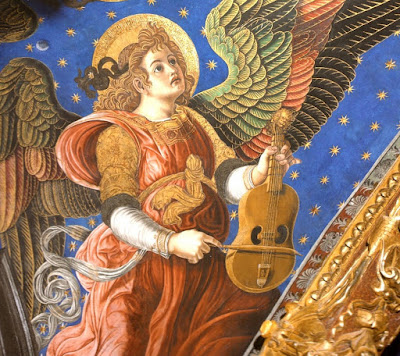Andrea Amati. circa 1505 to 1577
Much begins with this founding member of the Amati violin making family.
Andrea Amati's instruments begin generations of violin making in Cremona. His work refined and established the violin family we know today. And, Andrea handed down the principles of construction and design that carried Cremona violin making to a pinnacle that still stands an unmatched height today, nearly 500 years later.
A good while before Andrea's life, a bowed version of the vihuela and similar bowed string instruments had come into Italy (probably through Spain).
For several generations before Amati, Italian luthiers experimented making a range of bowed stringed instruments with combinations of different features. Some of these may have come very close to the eventual violin.
circa 1725 lira da Braccio by Giovanni Maria da Brescia:
It's unclear if the early violas or cellos from Brescia for example might have preceded Amati's work. In any event, Andrea Amati build violin type instruments in a full range of sizes, refined the design features of the family, and established the foundations and precedents upon which Cremona violin making develop, and eventually all violin making followed.
a viola by Andrea Amati:
In comparison, notice the somehow simpler but less elegant outline and corners of a Micheli viola:
It's unclear if the work of Micheli family or others in Brescia might have produced a viola or cello ahead of Andrea Amati. We might never get to know who made the first violin family instrument. But the Brescian works represented by this viola seem belong more to the past. Certainly the future development of the violin family grew instead out of Andrea Amati's work.
A viola head by Micheli with archaic scroll and additional cutout decorations of the pegbox:
While in Andrea Amati we see the modern scroll and pegbox:
Importantly, from 1564 to 1574 Andrea Amati worked on a commission from Charles IX of France for an ensemble of 38 instruments. These were in service in the French Court until the revolution of 1789. Such a large and conspicuous commission of instruments helped establish Andrea Amati's instruments as the archetype of the violin family.
Andrea's sons Antonio and Girolamo (Hieronymus) worked with their father, and then continued after him. Sometimes referred to as the 'Brothers Amati', Andrea's sons continued to experiment with and refine the violin family designs. Indeed, throughout all the great makers of Cremona, we see an ongoing combination of honoring traditions of violin design, while continuously experimenting and developing further.
In these first two generations of Amati makers, we actually see a wider range of sizes develop then is commonly used today.
Where we have basically the cello, viola, and violin, they had both a tenor and contralto size of viola, and large, small, and piccolo sizes of violins.
Beyond this, over the generations Cremona makers produced dancing master violins with very small but basically normal shaped bodies, Pochettes with very elongated skinny and often simplified bodies (literally to fit in the dance masters coat pocket), as well as other bowed strings of the Baroque and Classical eras like the Lira da Braccio, Viola d'amore, various Gambas (Viols), Barytons, and other stringed instruments.
Our current reduced range of sizes emerged after the Baroque era. Most of the now non-standard size instrument either fell out of use, or were altered to better fit the standard. The too small instruments mostly fell out of use. While the too large instruments were mostly cut down from their original size. For the most part, these resizing were done well enough that the instruments continue to be valued in concert performance. But, since the eventually standard size for cellos was a couple inches shorter than the normal cello size for the first century and half of Cremona making, very few cellos from those first several generations of Cremona makers haven't been cut down.
Here is a rare uncut example of the larger size cellos that were standard through the first several generations of Cremona makers.
The 1690 'Medici' cello by Stradivari:








No comments:
Post a Comment